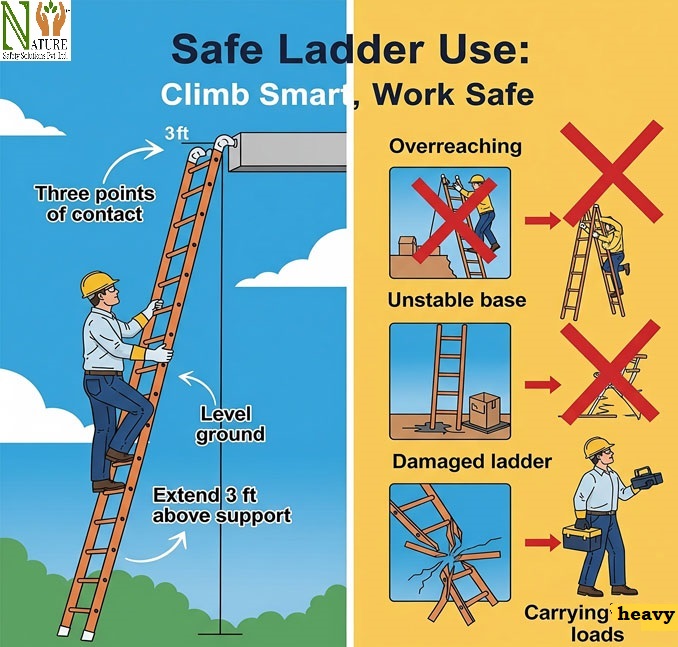Ladders help us reach places that are too high to access on our own. They are commonly used at home, in offices, on farms, and especially in construction and maintenance work. But while ladders are helpful, they can also be dangerous if used the wrong way.
Falls from ladders cause many injuries every year. Some of these injuries are serious and even life-threatening. That’s why it’s important to learn how to use ladders safely. By following a few simple rules, you can protect yourself and others from harm.

Choose the Right Ladder
Before you begin any job, make sure you have the correct ladder. A ladder that is too short or too weak can put you at serious risk. You should never try to stretch or stand on the top step to reach something. Instead, use a ladder that is tall enough for the task. Also, different ladders are made for different types of work.
Step ladders are good for indoor jobs, while extension ladders are better for outdoor use. If you are working near electrical wires, never use a metal ladder. Choose one made of fiberglass or wood to avoid electric shock.
Check the Ladder Before You Use It
A ladder may look fine at first glance, but it could have damage you don’t see right away. Always inspect your ladder before you use it. Look for cracks, bent steps, or loose screws. Make sure the steps are clean and dry.
If the ladder has rubber feet, check that they are not worn out or missing. A damaged ladder should never be used. It’s better to delay the job than to take a risk. A quick check can save you from a painful fall.
Set It Up the Right Way
Once you’ve chosen and inspected your ladder, it’s time to set it up. Always place the ladder on a flat, strong surface. Do not put it on boxes, rocks, or uneven ground just to make it taller. For extension ladders, follow the 4-to-1 rule: for every four feet of height, place the base one foot away from the wall. If you are using a step ladder, make sure it is fully open and the spreaders are locked in place. The area around the base should be clear of tools, wires, or anything else that could cause you to trip.
Climb Carefully
When climbing a ladder, take your time and do it the right way. Always face the ladder, and hold on with both hands. Do not carry tools in your hands while climbing—use a tool belt or raise them with a rope after you are in position. Keep your body straight and stay in the middle of the ladder. Don’t lean too far to the side. If you need to reach something out of range, climb down and move the ladder instead of stretching.
Don’t Overreach or Overload
One common mistake people make is trying to reach too far from the ladder. This can cause the ladder to tip over. You should always keep your belt buckle between the side rails. If you can’t reach something, it’s safer to move the ladder.
Also, ladders have weight limits. Before climbing, check the label for the ladder’s maximum capacity. This includes your body weight plus the weight of any tools or equipment you are carrying. Overloading the ladder can cause it to break or collapse.
Be Aware of Your Surroundings
The area around your ladder also matters. Wind, rain, or uneven surfaces can make ladder use very risky. Do not use ladders during bad weather, especially if you are working outdoors. Wet or icy surfaces increase the chance of slipping. If you are working near doors, make sure they are locked or blocked so no one opens them while you’re on the ladder. Always wear shoes that have non-slip soles to give you better grip.
Store and Move Ladders Properly
When you are done using the ladder, store it in a safe place. Keep it indoors if possible, away from direct sunlight, rain, or chemicals that can damage it over time. Do not leave it leaning against a wall outside where it could fall or be used improperly. If you are moving the ladder in a vehicle, tie it down securely to prevent it from shifting or falling during travel. Taking care of your ladder will help it last longer and stay safe to use.
Also read:-
